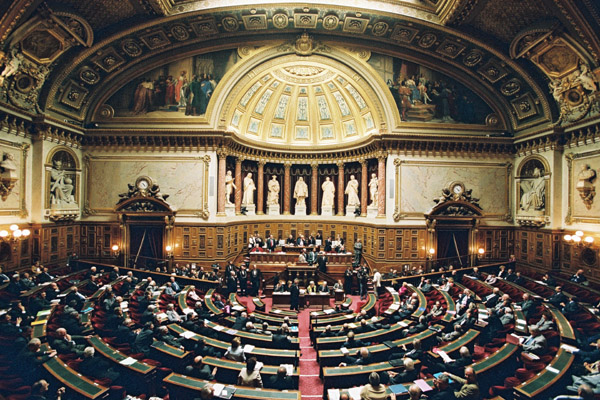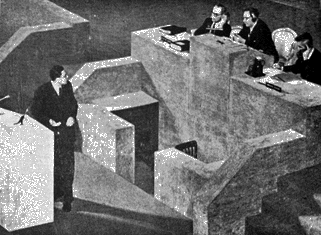|
|
Plinio Corrêa de Oliveira Spiritual Decoration vs. Materialist Decoration
"Catolicismo" N. 17 - May 1952 |
|
By no means. This is the tribune of the UN designed in accordance with a certain type of modern taste. On his feet, Andrei Gromyko, delegate of the USSR turns heavily toward the President, Percy Spender, to whom he declares that Russia will not sign the peace of San Francisco. Such is the level to which a certain “artistic” schools have reduced modern life.
In the Luxembourg Palace, the composition of the ambience took into consideration, not only the material and technical conveniences, but mainly the spiritual ones, by satisfying everything that the human spirit might require for the acts for which the hall is destined. It is a decoration made by men who believe in an immaterial soul. The tribune in which Gromyko speaks denies everything to the soul. It completely ignores the soul. It was constructed only in function of material conveniences. In a word, it is typically materialistic. Note: The preceding article has been translated and adapted for publication without the author's revision. –Ed. American TFP. |
|

 In
the first picture, 1,500 representatives of the United Nations meet in
the Assembly Chamber of the Luxembourg Palace built between 1615 and
1620 for Maria de Medici under the direction of Solomon de Brosse. The
ambience is admirably suited to an event of such magnitude. The very
natural order itself requires that places where great events take place
be full of good taste, dinstinction and brilliance. And that is what is
found there. This can be seen in the woodwork, colonnade, the simple and
noble lines of the tribune and table of the presidency and the solemn
bearing of the grand marble figures that illuminate the ambiance with
the splendor of centuries of culture and glory. One sees force, majesty,
grace and wealth. In a word, everything concurs to make one judge this
place worthy of a gathering of world representatives.
In
the first picture, 1,500 representatives of the United Nations meet in
the Assembly Chamber of the Luxembourg Palace built between 1615 and
1620 for Maria de Medici under the direction of Solomon de Brosse. The
ambience is admirably suited to an event of such magnitude. The very
natural order itself requires that places where great events take place
be full of good taste, dinstinction and brilliance. And that is what is
found there. This can be seen in the woodwork, colonnade, the simple and
noble lines of the tribune and table of the presidency and the solemn
bearing of the grand marble figures that illuminate the ambiance with
the splendor of centuries of culture and glory. One sees force, majesty,
grace and wealth. In a word, everything concurs to make one judge this
place worthy of a gathering of world representatives. Are
these the brutal, crushing sinisterly cold forms of a criminal tribunal?
Or is it a table for police interrogations, over which floats implicitly
but heavily the threat of a concentration camp?
Are
these the brutal, crushing sinisterly cold forms of a criminal tribunal?
Or is it a table for police interrogations, over which floats implicitly
but heavily the threat of a concentration camp?